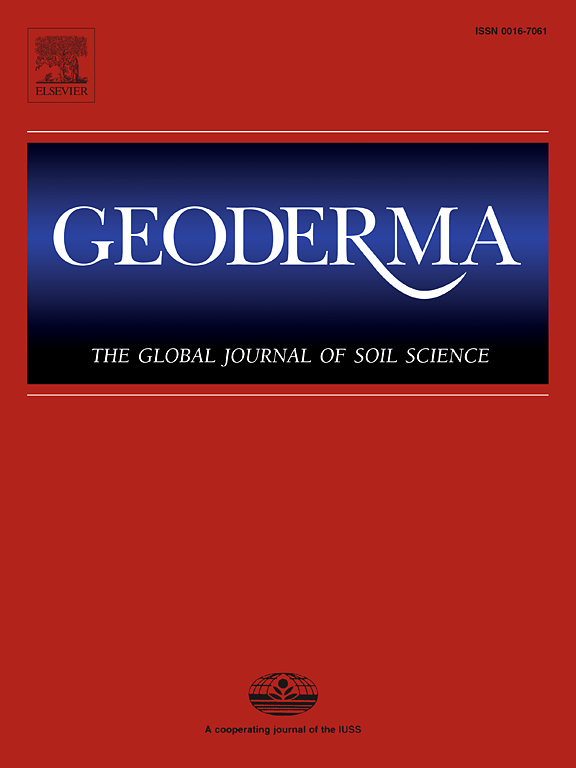利用多时段 PRISMA 成像光谱数据估算土壤有机碳
IF 5.6
1区 农林科学
Q1 SOIL SCIENCE
引用次数: 0
摘要
土壤是最大的陆地碳库,也是提供重要生态系统服务的宝贵资源。由于土壤面临退化的威胁,为了应对气候变化,我们需要了解土壤的现状,特别是土壤有机碳(SOC)的含量。空间成像光谱仪是绘制和监测土壤的一个很有前途的工具,它能够绘制最新、廉价和空间清晰的地图。特别是最近推出的新型高信噪比成像光谱传感器,为我们提供了新的可能性。其中之一就是将多时空成像光谱数据组合成空间覆盖率更高的 SOC 综合地图。本研究探讨了不同的多时相组合工作流程,以帮助找到最佳做法。据我们所知,这是第一次利用在德国北部同一研究地点记录的四幅 PRISMA 图像生成空间上更完整的 SOC 合成地图。我们对两种不同的计算工作流程进行了比较:工作流程一使用平均光谱创建合成裸土复合图,作为模型开发的基础。工作流程二是在对每幅图像进行单独的 SOC 建模后进行合成。在这些工作流程中,对估算 SOC 含量的不同方法进行了测试,其中包括一系列 SOC 光谱特征和两步局部 PLSR,该方法取代了湿化学 SOC 分析,可通过实验室光谱和大规模土壤光谱库进行模型校准和验证。结果表明,基于成像光谱数据生成多时复合 SOC 地图的最佳方法是工作流程二:使用 SOC 光谱特征方法合成 SOC 地图(R2 = 0.83,RPD = 2.42)。而工作流程二和传统的 PLSR 方法对所有输入日期都更稳健(R2 = 0.79,RPD = 2.21)。单幅图像的最佳结果 R2 值为 0.76-0.91,RPD 值在 2.06-3.42 之间。在测试的 SOC 光谱特征中,有三个特征的准确度与建模方法相当。这些结果对于提高空间覆盖率、完善 SOC 及其他土壤参数的绘图和监测工作是很有帮助的。需要在这一方向上开展进一步的调查,因为它们是即将到来的、可用性更强的业务成像光谱任务可行的先导。本文章由计算机程序翻译,如有差异,请以英文原文为准。

Estimating Soil Organic Carbon using multitemporal PRISMA imaging spectroscopy data
Soils are the largest terrestrial carbon pool and a valuable good that provides important ecosystem services. Since soils are threatened by degradation and in order to fight climate change the knowledge of the status quo especially of its soil organic carbon (SOC) content is required. A promising tool to map and monitor our soils are spaceborne imaging spectrometers which are able to produce up-to-date, inexpensive and spatially explicit maps. Especially the recent launch of new imaging spectroscopy sensors with a high signal-to-noise ratio opens up new possibilities. One of those is the combination of multitemporal spaceborne imaging spectroscopy data into SOC composite maps with a higher spatial coverage. This study explores different multitemporal combination workflows in order to support finding a best practice. To our knowledge for the first time, a spatially more complete SOC composite map was generated using four PRISMA images recorded over the same study site in northern Germany. Two different workflows of computation were compared: workflow one, creates a synthetical bare soil composite using averaged spectra as a basis for model development. Workflow two uses compositing after individual SOC modeling for each image. Within these workflows, different approaches were tested to estimate the SOC content, amongst them are a range of SOC spectral features and a two-step local PLSR which replaces the wet-chemistry SOC analyses for model calibration and validation by laboratory spectra and a large scale soil spectral library. Results show that the best method to produce a multitemporal composite SOC map based on imaging spectroscopy data was workflow two: the SOC maps composite, using the SOC spectral feature approach (R = 0.83, RPD = 2.42). While workflow two and the traditional PLSR approach was more robust for all input dates (R = 0.79, RPD = 2.21). Best results of the single images reached R values of 0.76-0.91 and RPD values ranging between 2.06-3.42. Three of the tested SOC spectral features provided accuracies comparable to the modeling approaches. These results are promising regarding the improvement of the spatial coverage and the refinement of the mapping and monitoring of SOC and other soil parameters. Further investigations in this direction are needed as they are precursors of what will be feasible by upcoming operational imaging spectroscopy missions with increased availability.
求助全文
通过发布文献求助,成功后即可免费获取论文全文。
去求助
来源期刊

Geoderma
农林科学-土壤科学
CiteScore
11.80
自引率
6.60%
发文量
597
审稿时长
58 days
期刊介绍:
Geoderma - the global journal of soil science - welcomes authors, readers and soil research from all parts of the world, encourages worldwide soil studies, and embraces all aspects of soil science and its associated pedagogy. The journal particularly welcomes interdisciplinary work focusing on dynamic soil processes and functions across space and time.
 求助内容:
求助内容: 应助结果提醒方式:
应助结果提醒方式:


